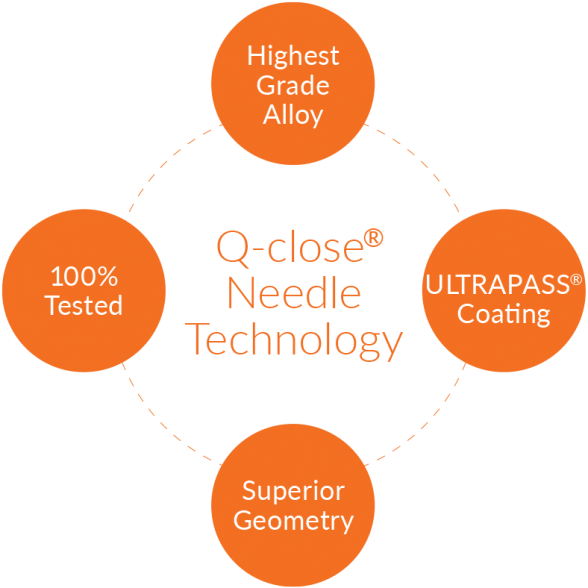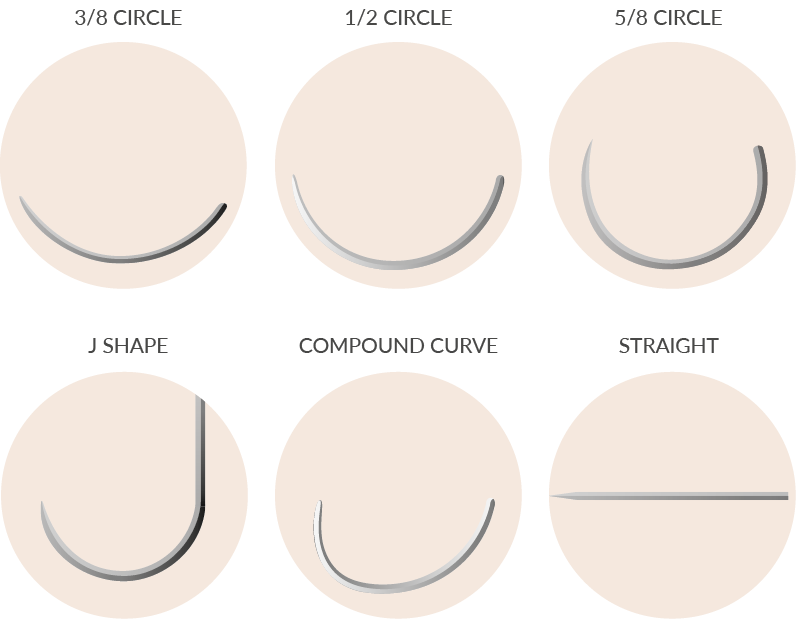The high-quality needles in our comprehensive Q-close suture range allow the surgeon to select the needle geometry and point most appropriate for the tissue being sutured. Our needles are manufactured to offer maximum strength, stability, precision, and reliability.
Q-close Needles
Strength, Stability, Precision and Reliability

Q-close Needle Technology
Highest Grade Alloy
All of our needles are manufactured with bend-resistant 300 Series stainless steel making them the strongest needles possible, and offering greater control and precision during surgery.
ULTRAPASS® Coating
Every needle in the Q-close suture range is coated with ULTRAPASS, a unique formulation of medical grade silicone. ULTRAPASS needles are designed so that the needle penetrates easily and consistently during repeated passage through tissue, thereby reducing force required and minimising tissue trauma.

Superior Geometry
Q-close needles are manufactured with square-body geometry wherever possible in order to provide additional strength, and increased stability in the needle holder.
100% Tested for Superior Strength of Needle Attachments
Q-close needles are manufactured with square-body geometry wherever possible in order to provide additional strength, and increased stability in the needle holder.
Needle Points
Blunt Tip
Q-close Blunt Tip needles are designed for safety. Their design enables penetration of tough tissue but not skin, and as such our Blunt Tip needles reduce the risk of glove puncture and needlestick injury. The Blunt Tip of these needles dissect rather than cut tissue, also making them ideal for suturing friable tissue, such as the liver or kidneys.
Taper Point
Q-close Taper Point needles gradually taper from the body of the needle to form a sharp point. This profile allows for gentle and easy separation of fibrous tissues, and minimises tissue trauma. Q-close Taper Point needles are also available as Black needles where enhanced visibility is required against tissue or blood.
Taper Cutting
Q-close Taper Cutting needles taper from the body and end with a short cutting tip. This design gives greater initial penetration through tougher tissues, whilst minimising tissue trauma in the same manner as a Taper Point needle.
Trocar Point
Q-close Trocar Point needles have a strong cutting head which allows for powerful penetration in tough tissues. The edges of the needle tip are sharpened to enable a cutting action, with the smallest hole possible in order to minimise tissue trauma.
Reverse Cutting
Q-close Reverse Cutting needles have a triangular cross section with the cutting edge on the outside edge of the needle curve, which gives the needle greater strength and resistance to bending.
Q-close PRECISION Reverse Cutting needles have a thinner, sharper tip giving greater penetration and precise control in surgery.
Conventional Cutting
Q-close Conventional Cutting needles have a triangular cross section with the cutting edge on the inside edge of the needle curve.
Q-close PRECISION Conventional Cutting needles have a thinner, sharper tip giving greater penetration and precise control in surgery.
Needle Curvature
Needle curvature is important in relation to how easy it is to reach the tissue being sutured. For example, tissue in deep and confined spaces will require a greater curvature to assist the clinician in getting the required access. Q-close needles come in a range of shapes to support clinical need.
3/8 Circle | ½ Circle | 5/8 Circle | J Shape | Compound Curve | Straight

Needle Length
Needle length is measured in millimetres and represents the distance measured along the needle from the needle point to the opposite end. When selecting needle size, it is important to choose a needle with sufficient length to pass through the tissue being sutured, and to be able grasp the needle at entry and exit points.

